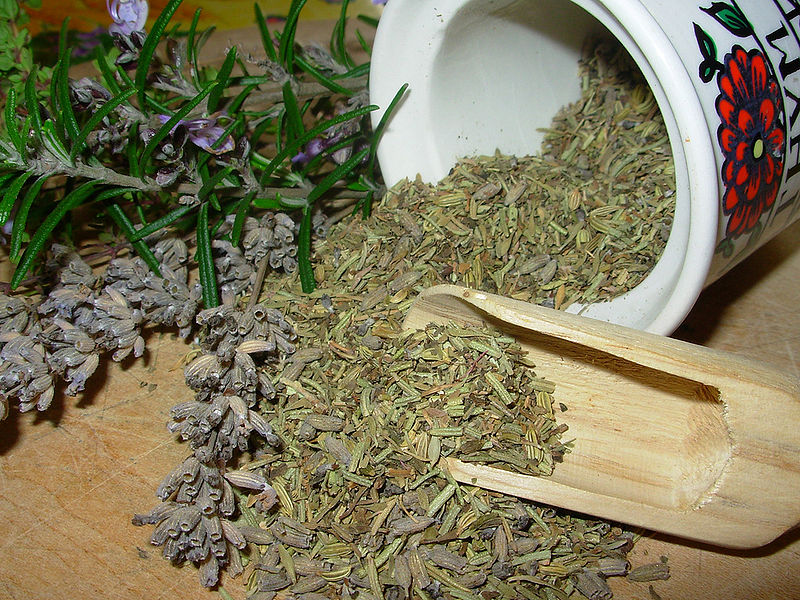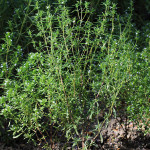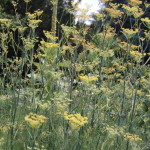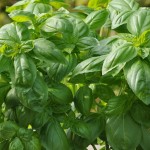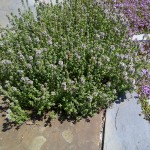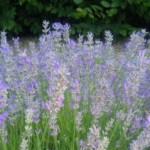Herbes de Provence is readily available in your grocery store . . . and in your herb garden. You can easily grow the savory, fennel, basil, thyme and lavender found in the commercial mixtures.
Savory – a member of the mint family, savory comes in two varieties: summer savory (Satureja hortensis), which is an annual, and winter savory (Satureja montana), which is a perennial. Both are members of the mint family. Summer savory is invasive. It will freely self sow all over your garden. For your herbes de Provence, you want to grow summer savory.
Summer savory is easily grown from seed. You can either direct sow the seeds in your sunny garden after the last frost or you can start them indoors 4 to 6 weeks before the last frost. Be patient! Summer savory seeds are slow to germinate. Mature plants will reach 18 inches in height. Once established, summer savory prefers to be dry. This makes it perfect for container growing since containers dry out quickly if you don’t water every day.
Summer savory can be harvested within six weeks. The plants should be a minimum of six inches high before the first harvest. Wait at least another month before you begin regular harvesting of the leaves and stems. Regular harvests keep the plants pruned. They tend to be top heavy and should be kept to a height of 12 inches.
Fennel – Foeniculum vulgare A member of the carrot family, fennel has two varieties: those that develop bulbs and those that don’t. Because you will be using the dried seeds in your herbes de Provence, you want to grow fennel that doesn’t develop a bulb. Allowing a bulb forming fennel to go to seed causes the bulb to become bitter. Fennel is a perennial that is hardy in zones 5 – 10.
Fennel is easily grown from seed. It’s best to sow the seeds in your sunny garden directly rather than starting them indoors. Fennel has a long tap root so it doesn’t transplant well. Nor does it do well in containers unless they are very deep to accommodate the root. The long tap root makes it a drought tolerant plant. Don’t over water it! Mature plants reach a height of five feet.
Harvesting the seeds is easy. Allow the flowers to die (don’t deadhead them) and form seed. When the seeds are brown, they are ready to harvest. There are a number of ways to do this. You can wrap the seed head in cheesecloth and shake the seeds off or you can use my preferred method of cutting the whole seed head off, place it in a paper bag, then seal the bag and shake it.
Basil – Ocimum basilicum A member of the mint family, basil is an annual that comes in seemingly infinite varieties. For your herbes de Provence, you want to grow any variety that is a sweet basil. A flavorful favorite is the heirloom variety, Genovese.
Basil is easily grown from seed. If you have a long, hot summer you can sow the seeds directly in your sunny garden. For those of us who live further north, it’s best to start basil indoors 8 weeks before your last frost date. Don’t move your plants outdoors until all danger of frost is past. Basil is originally from tropical areas of India, so it can’t withstand cold weather. The hotter the temperature, the better your basil will grow. Just don’t let it flower. Flowering causes the leaves to taste bitter. Aggressively pinch off all flowers to keep your basil producing all summer. Basil grows great in containers. Just make sure that they are well-watered. Don’t let your plants dry out.
You can begin harvesting leaves when your basil reaches a height of six inches. Don’t remove all or most of the leaves at once or you may kill your plant.
Thyme –Thymus vulgaris A member of the mint family, thyme is small, shrubby perennial that is hardy in zones 5 – 9 and comes in three varieties: broad-leaved, narrow-leaved and variegated. For your herbes de Provence, you want to grow one of the narrow-leaved varieties. They are the most aromatic.
Thyme is difficult to grow from seed. It is better to either buy a thyme plant or if you are fortunate to know a fellow gardener who is dividing their thyme, you can ask for a division. Mature plants range in size from 6 to 12 inches, depending on the variety. Thyme prefers a sunny location, but it can tolerate a little shade. What it can’t tolerate is over watering. Thymes are drought tolerant plants. If you water them too much, they rot.
You can harvest your thyme after it becomes established in your garden. Prune only what you need plus any brown, dead branches unless you live in a warmer climate. In that case, you should prune it hard in the early spring to prevent it from becoming too woody.
Lavender – a member of the mint family, lavender is a shrubby perennial that comes in seemingly infinite varieties. When purchasing lavender, look at the Latin name. There are three types of lavender commonly offered for sale: Lavandula angustifolia (known as English lavender), L. stoechas (known as Spanish lavender, the flowers look like butterflies), and L. dentata (known as French lavender, the leaves are serrated). For your herbes de Provence, you want to grow L. angustifolia.
English lavender is hardy in zones 5-8. Which variety you choose depends entirely on the amount of space you have. If you have only a small amount of space or are growing your herbs in containers, choose either “Hidcote” which grows to 24 inches or “Munstead” which grows to 18 inches. If you are blessed with a large garden, I highly recommend “Provence” which is used in the perfume industry and grows to 30 inches. Another good choice is “Grosso” which also grows to 30 inches. Another popular cultivar is called “Phenomenal” and grows to 32 inches. All three will become small shrubs so make sure you give them enough space.
Lavender is easy to grow and seemingly indestructible. In some parts of Europe, it’s considered an invasive weed! Don’t waste your money buying seed. The germination rate is miniscule except for an AAS variety called Lady Lavender which is very tiny and not terribly fragrant. Buy a plant and put it in the sunniest, hottest, driest spot in your garden and then forget about it. Nothing will grow along your driveway or in the hell strip between the sidewalk and the street? Lavender will love it there.
Be cruel to keep your lavender healthy. After it flowers, prune it back by ⅓ to ½. Because it’s a woody plant, hedge trimmers and weed eaters (strimmers) work really well if you have multiple plants. I once stepped on an old lavender plant that I thought was on its last legs virtually destroying it. The following year it grew back bigger and better than ever.
You will be using the lavender flowers for your herbes de Provence. Harvest the flowers and the stems (wands) when the buds are just beginning to open. Tie the wands together and hang them in a dark, dry place that is well ventilated until the flowers are completely dry. Remove the stems before you add them to your herbes de Provence.
Making Herbes de Provence – You will need to dry your herbs. We have already discussed how to dry the fennel seeds and lavender flowers. You can dry the basil, savory and thyme using the same method as the lavender flowers or you can use a food dehydrator. You can even dry them in your oven. Spread the leaves on parchment paper covered cookie sheets, then place the cookie sheets in a 100°F-110°F oven for two to three hours.
To make your herbes de Provence, simply combine your herbs in a 1:1:1:1:1 mixture, for instance 1 tablespoon of each. Once you have made your herbes de Provence mixture, place the mixture in an air tight container and store it in a cool, dark place with no sun exposure.
More Herb Blends
Bouquet Garni
Chinese Five Spice Blend
Curry Blend
Fines Herbes
Italian Seasoning
Old Bay Seasoning
Paprika
Poultry Seasoning
Za’atar

